
Aquarium fish breeding isn’t that difficult if you choose the right fish, in fact with some fish it’s difficult to stop them from breeding!
Livebearers are the easiest fish to breed on this list, but anyone can breed them…so I’ve included some easy to breed egg laying fish too.
Also included are some alternative suggestions for what else you could breed in your aquarium and tips on setting up a tank for breeding.
18 Easiest Fish To Breed In A Freshwater Aquarium
These are the easiest fish to breed in a freshwater tank based on my experience, they don’t need any special requirements other than basic aquarium equipment.
1. Angelfish
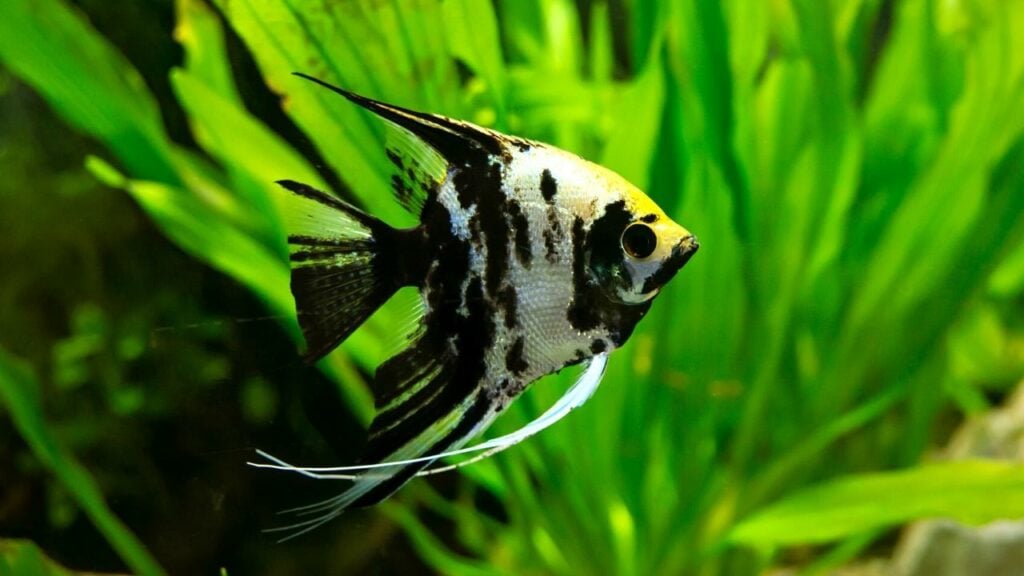
- Scientific Name: Pterophyllum scalare
- Care Level: Easy
- Breeding Difficulty: Easy
- Egg Layer or Livebearer: Egg layer
- Temperament: Semi-aggressive
- Maximum Size: 6 inches
- Breeding Tank Size: 20 gallons (tall rather than long)
- Diet: Omnivore
- Water Temperature: 78°-84° F
- dKH: 5-13
- pH: 6.5-7.5
Angelfish pair up for life. Either buy a breeding pair or buy 6-8 juveniles from the fish store and they will pair up, it may take 6-9 months though, so a little patience is required.
Angelfish lay eggs on smooth vertical surfaces, such as an Amazon sword plant leaf, a slate tile propped up, or a breeding cone.
Angelfish will take care of eggs and raise the fry themselves, they can lay up to 300 eggs.
The first couple of times your angelfish may eat the eggs, but they will get the hang of it eventually, and by the third time that they lay some eggs, they should hatch.
If you struggle to get your angels to breed, when performing a water change, drop the temperature by 5-8° F. This simulates the rainy season and encourages them to spawn.
2. Betta Fish
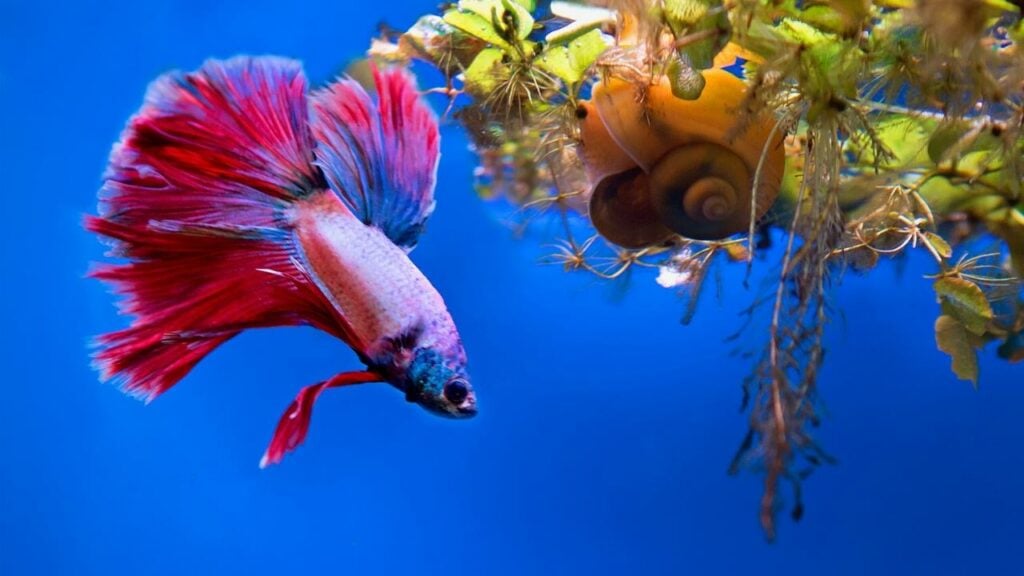
- Scientific Name: Betta splendens
- Care Level: Easy
- Breeding Difficulty: Moderate
- Egg Layer or Livebearer: Egg layers
- Temperament: Semi-aggressive
- Maximum Size: 3 inches
- Breeding Tank Size: 5 gallons
- Diet: Carnivore
- Water Temperature: 78°-82° F
- dKH: 5-20
- pH: 6.5-7.5
Male betta fish have longer and flatter bodies and much more elaborate fins than females.
You will only need 1 male and 1 female for breeding.
I don’t advise keeping more than 1 betta in a tank (male or female) other than for breeding purposes so you’ll need to set up a separate breeding tank.
You’ll need to feed them a high protein diet to prepare them for breeding and provide a floating plant for the male to build a bubble nest beneath, Indian almond leaves also work well.
You’ll know that they’re ready to breed when the female has developed vertical stripes along her sides and the male has built his bubble nest.
They embrace beneath the nest and the female releases her eggs. It may take a few tries, but they’ll get there.
The male places each egg in a separate bubble and takes care of them until they hatch.
Breeding bettas is an intricate process, I have an in-depth section on breeding them in my betta fish care guide.
3. Bristlenose Pleco

- Scientific Name: Ancistrus sp.
- Care Level: Easy
- Breeding Difficulty: Easy
- Egg Layer or Livebearer: Egg layers
- Temperament: Peaceful
- Maximum Size: 6 inches
- Breeding Tank Size: 30 gallons
- Diet: Omnivore
- Water Temperature: 72°-82° F
- dKH: 6-10
- pH: 6.5-7.5
Males have more bristles on their noses when mature, so you can generally tell them apart from females.
Make sure they are well fed, plecos have a very healthy appetite and should have a plump belly.
Plecos appreciate having some driftwood in their tank, as they like to eat all the microorganisms that grow on it.
Bristlenose plecos breed in a cave or tube, make sure there is only a single entry/exit hole. Provide a few different size caves around the tank.
The male will wait in the tube or cave and lure in the female, do the deed, and then kick her out…who says chivalry is dead?!
The male looks after the eggs until they hatch.
If you struggle to get your plecos to breed, when performing a water change, drop the temperature by 5-8° F. This simulates the rainy season and encourages them to spawn.
4. Convict Cichlids
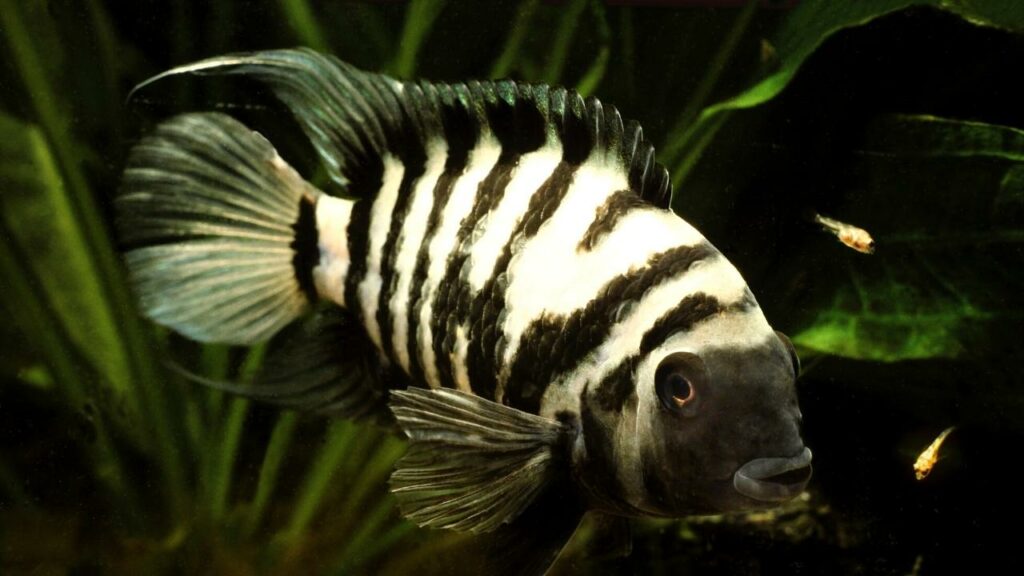
- Scientific Name: Amatitlania nigrofasciata
- Care Level: Easy
- Breeding Difficulty: Easy
- Egg Layer or Livebearer: Egg layers
- Temperament: Aggressive
- Maximum Size: 5 inches
- Breeding Tank Size: 30 gallons
- Diet: Omnivore
- Water Temperature: 77-84
- dKH: 9-20
- pH: 6.5-8.0
Males have longer fins. Females can have blue or orange tones on their bellies.
Buy 6 juveniles and wait until some pair off. Once they have paired off, it’s recommended you put them into a separate tank as they are very aggressive and will protect their eggs and fry at all costs!
They like rocks, caves, plenty of hiding spots and driftwood in their tank, and a decent water flow.
They are great parents and raise the young themselves.
Have a plan of what you are going to do with the fish once they have bred, as they grow fairly large you’ll need plenty of tank space for them or need someone to buy or take them off your hands.
5. Endler’s Livebearer

- Scientific Name: Poecilia sp.
- Care Level: Easy
- Breeding Difficulty: Easy
- Egg Layer or Livebearer: Livebearer
- Temperament: Peaceful
- Maximum Size: 1 inch
- Breeding Tank Size: 10 gallons
- Diet: Omnivore
- Water Temperature: 70°-82° F
- dKH: 10-30
- pH: 5.5-8.0
Males are more brightly colored than females.
It’s very easy to get endlers to breed, just put males and females in a tank and wait for the magic to happen! Put 1 male per 3 females.
Endlers breed every 22 days, the female endlers will develop a gravid spot on the rear of their abdomen when pregnant.
It’s important to provide plenty of hiding places such as java moss or water wisteria for the baby endlers to hide in, as the parents may mistake them for food and eat them.
Every few months it is recommended to add a couple of new endlers into the mix, to help stop inbreeding. This gives you a stronger gene pool and healthier fish.
6. Guppies

- Scientific Name: Poecilia reticulata
- Care Level: Easy
- Breeding Difficulty: Easy
- Egg Layer or Livebearer: Livebearer
- Temperament: Peaceful
- Maximum Size: 2 inches
- Breeding Tank Size: 10 gallons+
- Diet: Omnivore
- Water Temperature: 72°-80° F
- dKH: 8-12
- pH: 7.0-8.2
Male guppies are much more colorful than females.
Guppies probably take the crown as the easiest fish to breed, closely followed by all the other live-bearing fish on this list.
It’s hard to stop guppies from breeding, add 1 male per 3 females to a tank and that’s it, you will have baby guppies within a few weeks.
Female guppies will develop a gravid spot when pregnant.
Make sure you provide plenty of hiding spots for the guppy fry to hide, java moss and guppy grass are great options and work well.
When choosing guppies to breed, make sure they look healthy, are not skinny, and are active.
Guppies have been bred a lot over the years and this has led to some health issues. If you want healthy fry, you need to start with healthy parents.
I’ve done an in-depth guppy care guide, which covers the breeding process in much more detail.
7. Kribensis Cichlid
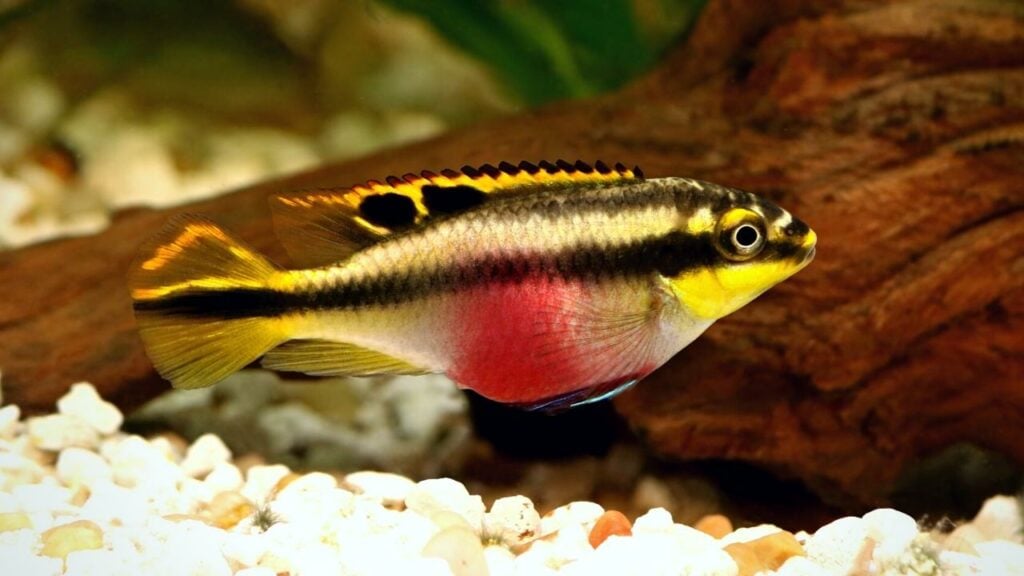
- Scientific Name: Pelvicachromis pulcher
- Care Level: Easy
- Breeding Difficulty: Easy
- Egg Layer or Livebearer: Egg layer
- Temperament: Generally Peaceful
- Maximum Size: 4 inches
- Breeding Tank Size: 30 gallons
- Diet: Omnivore
- Water Temperature: 75°-82° F
- dKH: 5-20
- pH: 5.0-8.0
Females are smaller and more colorful, with a lovely cerise patch on their belly.
Keep 1 male and 1 female in a tank with plenty of caves that have only a single entry/exit point.
Half a coconut shell or a terracotta pot on its side works well.
They are good parents and raise the fry, although they can be kept in a community tank (which is rare for a cichlid!) they can be defensive when breeding, so it’s best to keep them in a tank on their own to increase the chances of the baby fish surviving.
8. Least Killifish
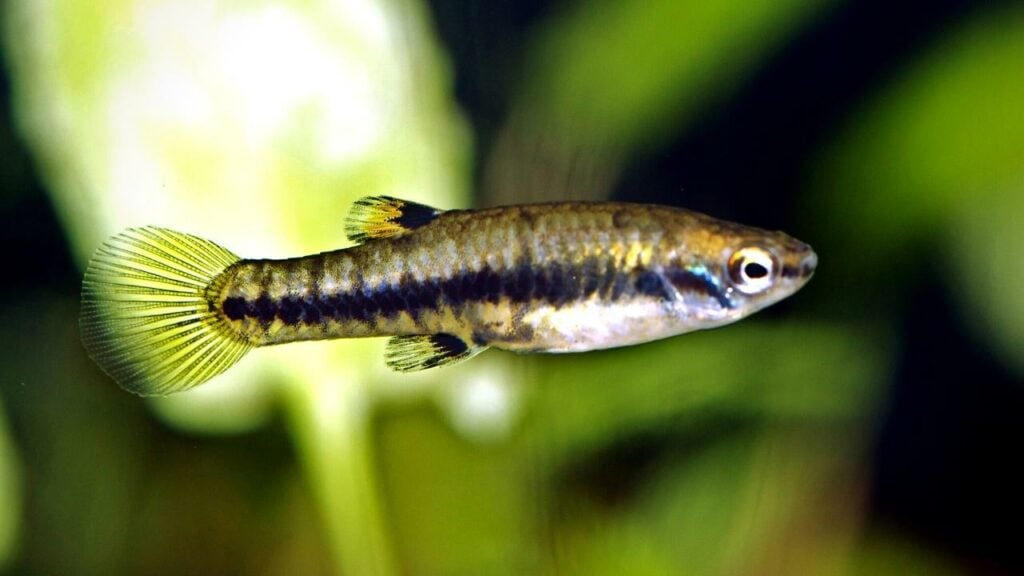
- Scientific Name: Heterandria formosa
- Care Level: Easy
- Breeding Difficulty: Easy
- Egg Layer or Livebearer: Livebearer
- Temperament: Peaceful
- Maximum Size: 1.25 inches
- Breeding Tank Size: 10 gallons
- Diet: Omnivore
- Water Temperature: 70°-80° F
- dKH: 5-20
- pH: 7.0-8.0
Females are larger than males, males grow up to 0.75″ whereas females can reach 1.25″.
Due to their small size, this is a great fish if you want to try breeding in a small or nano tank. They prefer harder water and can manage without a heater if you live somewhere warm year-round.
The least killifish are the smallest livebearer fish and have a unique way of giving birth.
They give birth to live young, but not all at once, it is more like a conveyor belt of babies being born each day.
They prefer a planted tank and the plants provide a good hiding spot for the fry.
9. Molly Fish
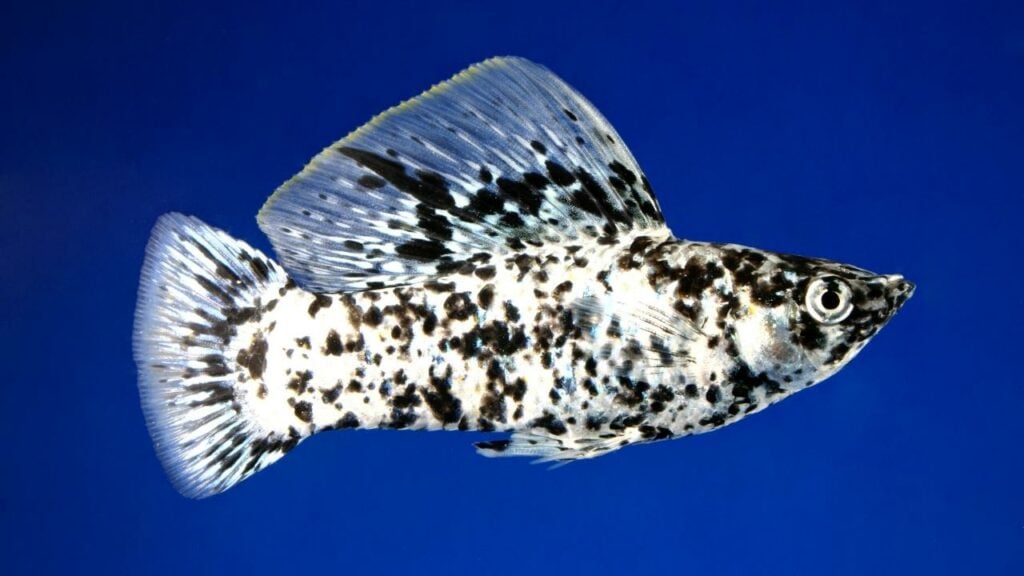
- Scientific Name: Poecilia latipinna
- Care Level: Moderate
- Breeding Difficulty: Easy
- Egg Layer or Livebearer: Livebearer
- Temperament: Peaceful
- Maximum Size: 4 inches
- Breeding Tank Size: 30 gallons
- Diet: Omnivore
- Water Temperature: 72°-82° F
- dKH: 10-25
- pH: 7.2-8.5
Males and females look similar, to tell them apart males have a gonopodium, whereas female mollies have a ‘regular’ shaped anal fin.
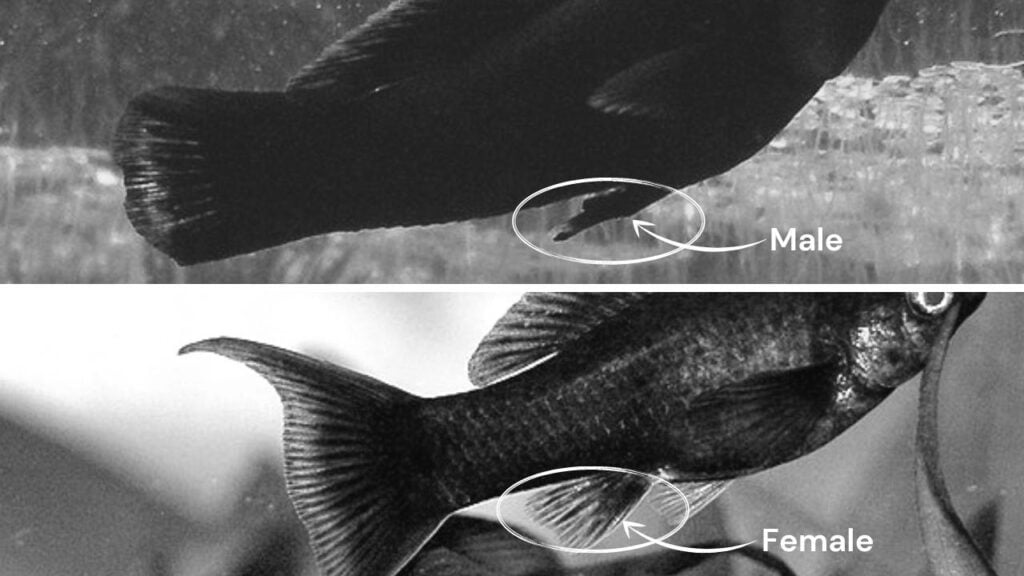
Keep 1 male per 3 females, the males will constantly harass the females to breed, so having a 1:3 ratio gives the ladies a bit of a break.
They can sometimes eat their fry, so it’s best to provide some plants that the fry can hide in such as java moss.
I’ve found mollies are prone to diseases, like ich or fungal infections, so you must quarantine any new mollies you buy, to check they are healthy before they breed.
10. Platy Fish
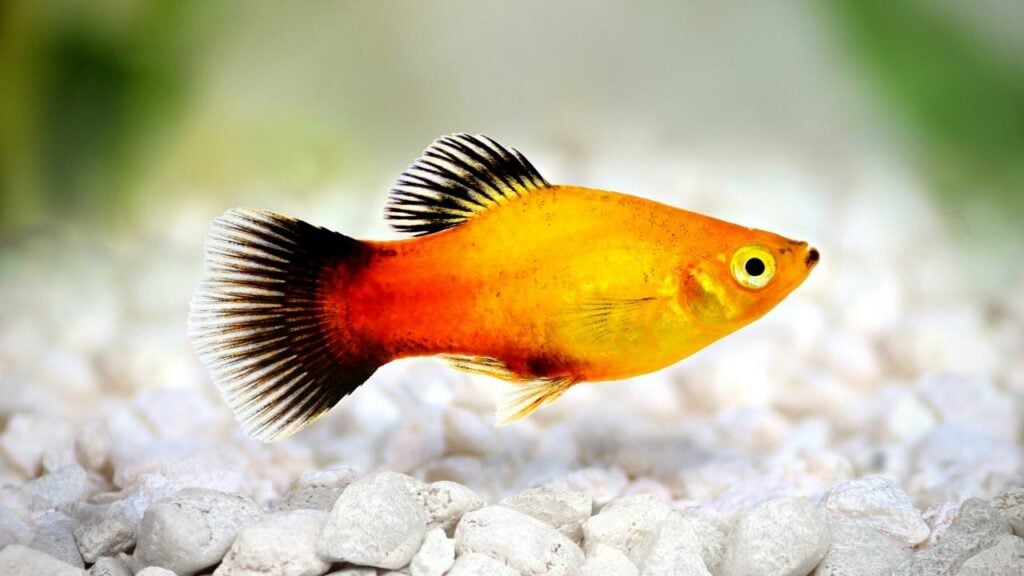
- Scientific Name: Xiphophorus maculatus
- Care Level: Easy
- Breeding Difficulty: Easy
- Egg Layer or Livebearer: Livebearer
- Temperament: Peaceful
- Maximum Size: 3 inches
- Breeding Tank Size: 30 gallons
- Diet: Omnivore
- Water Temperature: 70°-82° F
- dKH: 10-25
- pH: 6.8-8.0
Platies are available in a wide range of colors, you can tell males and females apart the same way as mollies. Males have a gonopodium, whereas females have a regular-shaped anal fin.
Keep 3 females per 1 male, females will be pregnant for around 1 month before giving birth to live young.
The parents (or other fish if they are in a community aquarium) may eat the fry, so it’s best to have plenty of plants for the fry to hide in and amongst.
Java moss and hornwort are some good options.
11. Rosy Barb

- Scientific Name: Puntius conchonius
- Care Level: Easy
- Breeding Difficulty: Easy
- Egg Layer or Livebearer: Egg layer
- Temperament: Semi-Aggressive
- Maximum Size: 6 inches
- Breeding Tank Size: 30 gallons
- Diet: Omnivore
- Water Temperature: 64°-72° F
- dKH: 4-10
- pH: 6.0-8.0
Males are larger and more brightly colored than females, males are a shimmery rosy orange color, whereas females are golden yellow.
You’ll need 1 male and 1 female for breeding.
In the breeding tank, you’ll need a breeding box or a floating basket with a mesh bottom, so that the fertilized eggs can fall through the basket, where they won’t get eaten by Mom or Dad.
Once the fertilized eggs have fallen through the basket, you can put the parents back into their regular tank.
It will take around 3 days for the eggs to hatch.
12. Rosy Red Minnow
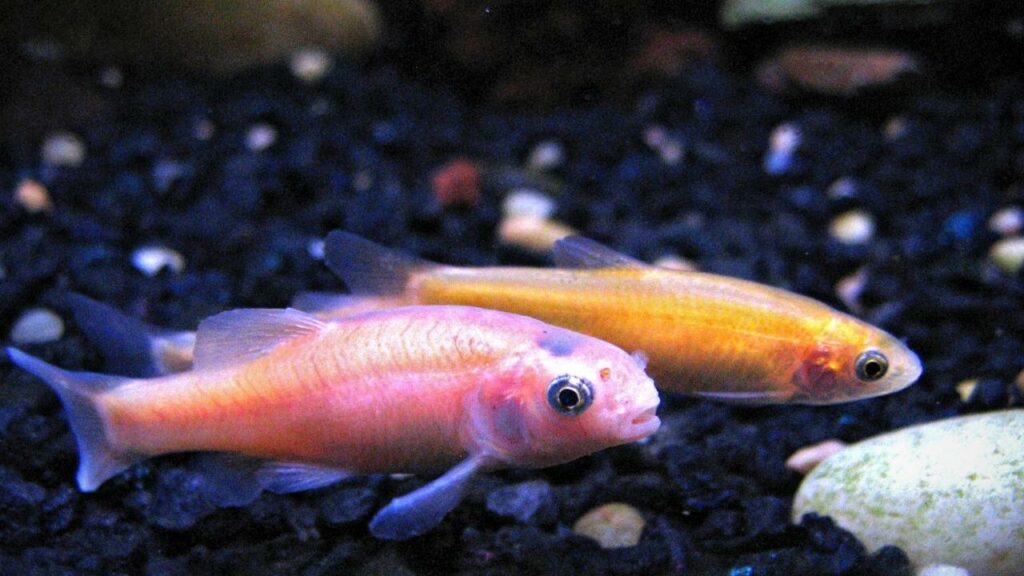
- Scientific Name: Pimephales promelas
- Care Level: Easy
- Breeding Difficulty: Easy
- Egg Layer or Livebearer: Egg layer
- Temperament: Peaceful
- Maximum Size: 3 inches
- Breeding Tank Size: 10 gallons
- Diet: Omnivore
- Water Temperature: 70°-80° F
- pH: 6.0-8.0
A male rosy red will grow up to 2-3″, whereas a female will grow up to 1-2″.
A ratio of 1 male to 1 female will work just fine for breeding.
They like caves and overhangs to lay their eggs. The male develops a tubercle on his head and uses it to clean the overhang or cave where he will lure in the female.
The male rosy red is no gentleman. Once he’s lured her into his cave they engage in a dance, as soon as she has deposited her eggs, he kicks her out of the cave!
The male guards the eggs until they hatch. He’ll rub an antifungal substance off his head onto the eggs and will take on much bigger fish than himself to defend them.
Once the eggs hatch, he loses interest and leaves the fry to fend for themselves.
13. Swordtail
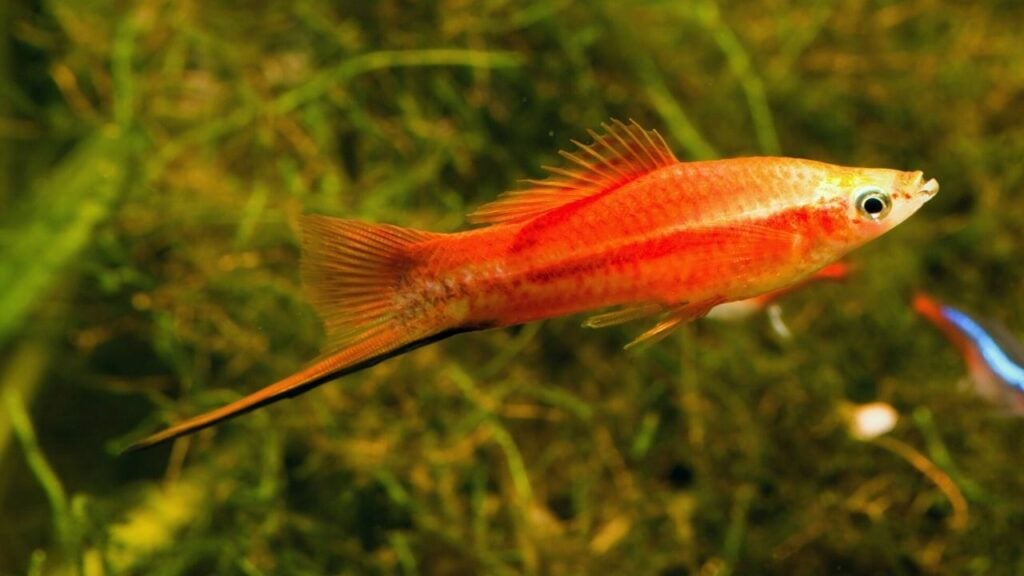
- Scientific Name: Xiphophorus helleri
- Care Level: Easy
- Breeding Difficulty: Easy
- Egg Layer or Livebearer: Livebearer
- Temperament: Peaceful
- Maximum Size: 6.5 inches
- Breeding Tank Size: 30 gallons
- Diet: Omnivore
- Water Temperature: 72°-82° F
- dKH:10-15
- pH: 7.0-8.5
Male and female swordtails are easy to tell apart. The males have a swordlike extension to their tails and are slimmer.
They are so easy to breed that all you have to do is put a male and female together in the same tank, that’s it!
After approx 28 days (I’ve known it to be anywhere from 21-30 days) the female’s abdomen will swell up and will be squared off in the corners. That’s how you can tell she’s ready to give birth.
Make sure you provide plenty of hiding places like rocks and plants for the fry as the parents will eat them.
14. White Cloud Mountain Minnow

- Scientific Name: Tanichthys albonubes
- Care Level: Easy
- Breeding Difficulty: Easy
- Egg Layer or Livebearer: Egg layer
- Temperament: Peaceful
- Maximum Size: 1.5 inches
- Breeding Tank Size: 10 gallons
- Diet: Omnivore
- Water Temperature: 65°-75° F
- dKH: 2-25
- pH: 6.5-8.0
The white cloud mountain minnow grows to approx 1.5″ in length. You can tell them apart as males have more vivid coloring and are slimmer than females.
A 1 male to 1 female ratio will work well for breeding them.
It’s best to breed these guys in a separate breeding tank as they will eat their eggs and fry.
Place a fine mesh at the bottom of the tank or use a floating basket with a mesh bottom, so the eggs can fall through and be kept away from the breeding fish.
Put the males and females in the breeding tank at night and leave them. They spawn at first light in the morning.
After they’ve spawned you can remove the adult fish and put them back into the main tank.
The eggs should hatch within the next 2 days and the fry becomes free swimming after a further 2 days.
Along with the rosy red minnows, white cloud mountain minnows are among the easiest feeder fish to breed.
15. Zebra Danios
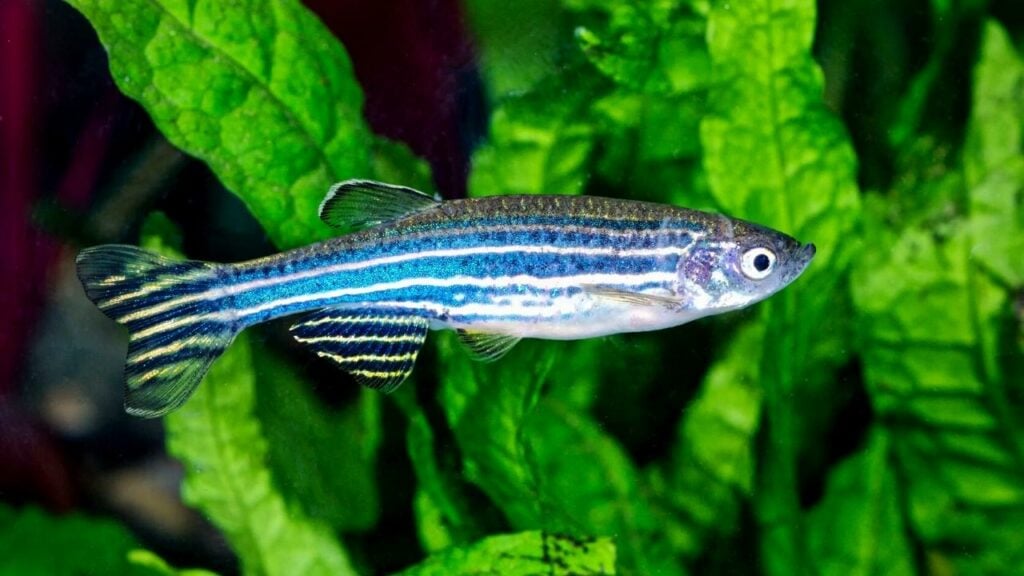
- Scientific Name: Danio rerio
- Care Level: Easy
- Breeding Difficulty: Easy
- Egg Layer or Livebearer: Egg layer
- Temperament: Peaceful
- Maximum Size: 2.5 inches
- Breeding Tank Size: 10 gallons
- Diet: Omnivore
- Water Temperature: 65°-80° F
- dKH:8-12
- pH: 6.5-7.5
Males are slimmer and more torpedo-shaped, whereas females tend to have a rounder belly.
Zebra danios pair up for life, so you can either buy a bonded pair or buy 5-6 of them and wait until they pair off, then separate them for breeding.
In a separate breeding tank, add a layer of coarse substrate, this allows the eggs to nestle and be protected from Mom and Dad eating them once they’ve spawned. Alternatively, you could use a breeding box that will allow the eggs to fall through the bottom.
Place the male and female together the last thing at night and leave them. They tend to spawn at first light in the morning.
Each female will release 200-300 eggs, once they’ve fully spawned remove the adult fish and put them back into their regular tank.
The eggs will hatch after approximately 2 days with the fry becoming free swimming around day 4.
If you struggle to get them to breed, perform a 50% water change to simulate the rainy season when there’s more food in the water, this will encourage them to spawn.
Shrimps
If you’d like to try something different from fish, shrimp are a great option for breeding.
Avoid the Amano shrimp though, as it’s notoriously difficult to breed.
I have found the cherry shrimp is by far the easiest shrimp to breed and they are great at eating algae and detritus in the tank, which is always a bonus.
16. Cherry Shrimp
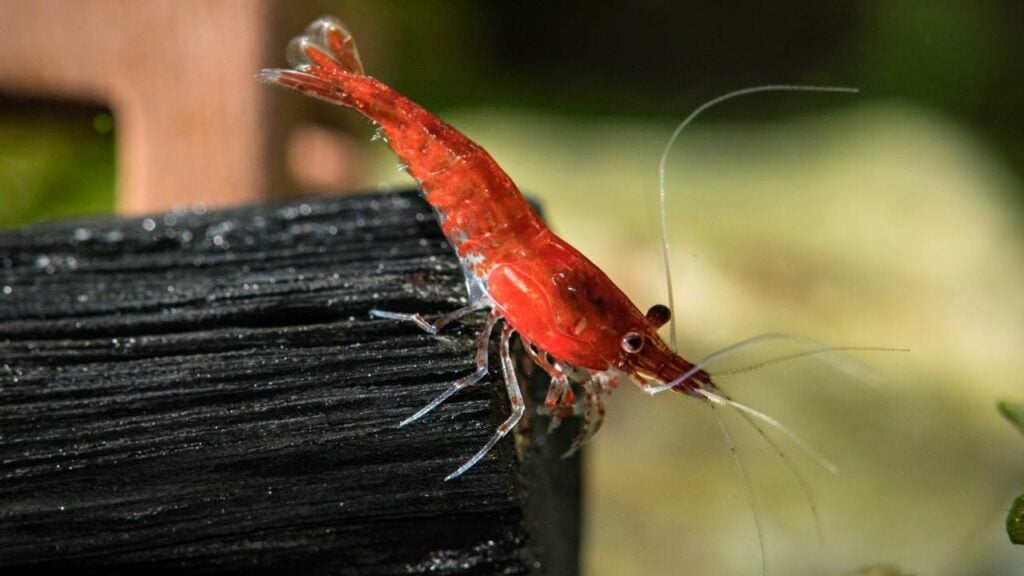
- Scientific Name: neocaridina davidi
- Care Level: Easy
- Breeding Difficulty: Easy
- Egg Layer or Livebearer: Livebearer
- Temperament: Peaceful
- Maximum Size: 1.5 inches
- Breeding Tank Size: 10 gallons
- Diet: Omnivore
- Water Temperature: 70°-80° F
- dKH: 3-8
- dGH: 6-15
- pH: 6.5-8.0
- TDS: 180-250
Despite their name, cherry shrimp come in a wide range of colors including red, yellow, and blue. Males are smaller and less colorful than females.
Cherry Shrimp are easy to breed, as long as you have stable water parameters, they don’t cope well with changes.
Add some shrimp to either a shrimp-only tank or a community tank, if added to a community tank, you need to be aware that shrimp fry is an irresistible snack for most fish!
Java moss and cholla wood are must-have additions to a shrimp tank, as they provide places for baby shrimp to hide.
Snails
Another option for something a little different to breed is snails.
Snails divide opinion, either you love ’em or hate ’em in your aquarium, but on the whole, it’s difficult to avoid having them in your tank at some point as they hitchhike in with fish and plants.
Some snails like ramshorn snails are hermaphrodites, so you don’t need a male and female to reproduce, you can end up with 100’s of snails and become overrun with them very quickly! You can help combat this with snail-eating fish like cichlids or loaches.
The Malaysian trumpet snail isn’t a hermaphrodite, but females can produce clone offspring through a process called parthenogenesis, again you can be overrun with these snails pretty fast.
I’ve selected 2 snails that don’t reproduce too quickly, so you are much less likely to have a snail invasion on your hands.
17. Mystery Snail

- Scientific Name: Pomacea bridgesii
- Care Level: Easy
- Breeding Difficulty: Easy
- Egg Layer or Livebearer: Egg layer
- Temperament: Peaceful
- Maximum Size: 3 inches
- Breeding Tank Size: 10 gallons
- Diet: Omnivore
- Water Temperature: 68°-84° F
- dKH: 12-18
- pH: 7.6-8.4
One of the most popular aquarium snails, they come in an array of colors, so you are sure to find one you like.
Mystery Snails are fairly easy to breed, you will require a male and female as they are not hermaphrodites.
Make sure your water level is 3-4 inches below the rim of the tank, as the female will leave the water to lay a clump of eggs above the water’s surface.
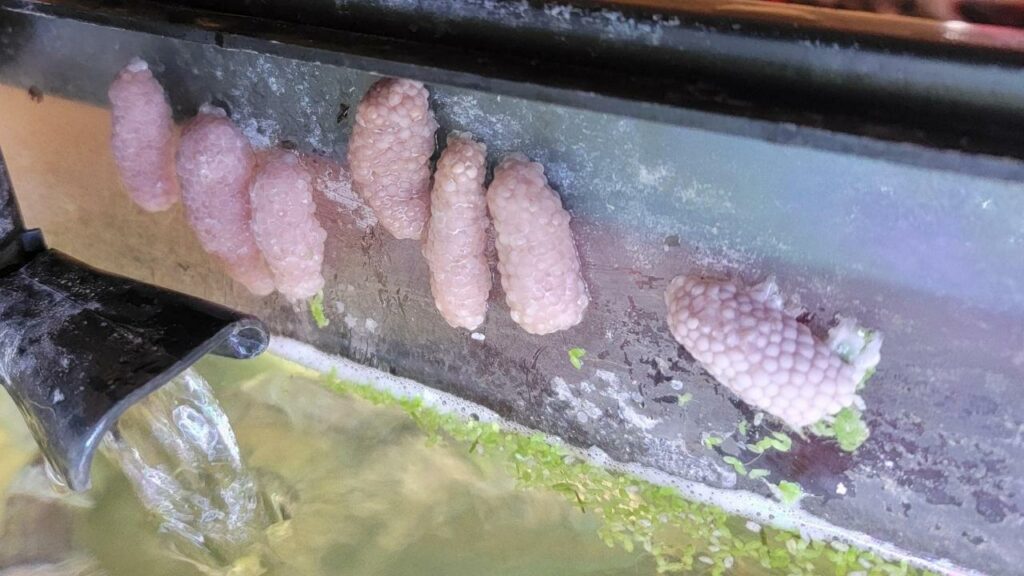
The eggs will hatch in 2-4 weeks.
18. Rabbit Snail
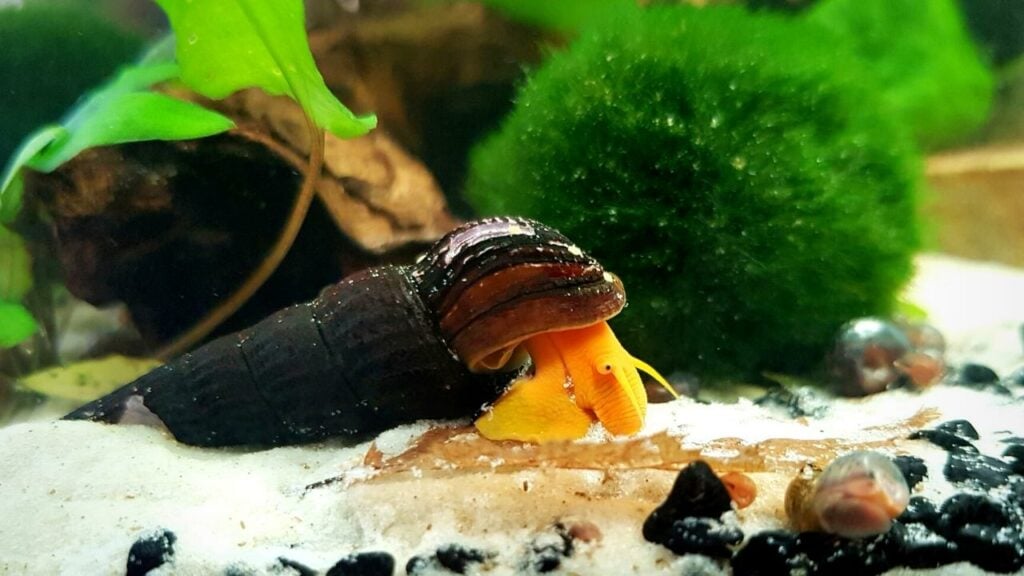
- Scientific Name: Tylomelania sp.
- Care Level: Easy
- Breeding Difficulty: Easy
- Egg Layer or Livebearer: Egg layer
- Temperament: Peaceful
- Maximum Size: 5 inches
- Breeding Tank Size: 30 gallons
- Diet: Omnivore
- Water Temperature: 70°-84° F
- dKH: 2-15
- pH: 7.3-8.5
The rabbit snail, also known as the elephant snail is unusual looking and is sure to grab anyone’s attention who sees it in your tank.
They come in a variety of colors, my favorite is the yellow rabbit snail.
You can breed rabbit snails fairly easily, you will require a male and female as they are not hermaphrodites.
You don’t have to worry about them overrunning your tank, as they breed slowly (1-2 babies every 4-6 weeks).
It’s cool to watch the fully formed baby snail emerge from the small milky sac.
How To Care For Your Breeding Fish
A few things to consider when breeding fish are:
Choose Healthy Fish
Make sure the fish are in peak condition for breeding.
The fish you are going to breed need to be healthy, lively, and not skinny-looking.
If you want healthy babies, you need healthy parents.
Feeding Breeding Fish
Before breeding your fish, make sure they are well-fed with a high-quality diet and some additional protein like brine shrimp or bloodworms in the week before you breed them.
This encourages the female to produce more eggs and gets the fish prepared and in peak condition for breeding.
Plan Ahead
Make a plan for what you’re going to do with the fry (baby fish) ahead of time.
- Are they to feed other fish?
- Do you want to sell them to your local pet store, friends, or other aquarists in your area?
- Are you going to keep them for your display tank?
If you’re setting up separate breeding tanks, remember to cycle the tank before adding any fish.
Fry are more sensitive to ammonia poisoning than adult fish.
Enough Space
An obvious point to cover is space. If you’re breeding fish as additions to your community tank, is the tank big enough to handle the extra bio load without crashing the tank’s nitrogen cycle?
Some fish, such as convict cichlids are very protective of their young and will be aggressive towards any other fish in the tank. It’s best to keep these types of fish in a separate species-only breeding tank.
If you’re going to sell the fish for profit you’ll need separate holding tanks. A reputable breeder should keep their males and females separated.
Provide Hiding Spots

Make sure you provide hiding spots for your fish and their fry.
Some fish such as plecos and rosy red minnows prefer caves, some fish prefer nice dense plants that they can hide amongst and feel safe.
Check what you need to provide for the species of fish you want to breed.
Have A Filter
Sponge filters are the best option for breeding tanks. They don’t suck in the fry and they are great for beneficial bacteria to grow on.
You’ll also see fish and fry feeding off any trapped food or algae on the sponge filter.
If you already have a HOB filter, fit a pre-filter sponge over the intake to stop the eggs and fry from being sucked in.
Feeding Fry
When it comes to feeding the fry, you can feed them Infusoria and grind up regular high-quality fish flakes.
After a few days when the fish have grown, you can add baby brine shrimp to their diet.
Baby brine shrimp are easy to hatch by yourself, and if you’re considering breeding lots of fish it’s worth looking into having your own baby brine shrimp hatchery as it will save you money in the long run.
It’s a high-quality food that the fry will eagerly gobble up.
Tips For Breeding Fish For Profit
If you’re looking at setting up your own fish breeding business, my top tips are:
High Demand Fish
To sell the most fish and make the most money, find out what fish are in high demand and breed those.
Don’t waste your time and effort breeding fish that nobody wants.
Expensive or Rare Fish
Fish that are rare and hard to get hold of from your local fish store can be the most profitable fish to breed as they can command a higher price.
The downside is, that these rarer fish can be more difficult to breed.
Start off with some easier fish to breed and work your way up to the more difficult fish.
Java Moss
Java moss is a great tropical plant to grow and sell as it’s one of the most popular plants in the aquarium hobby.
Java moss is very hardy, doesn’t need any special lighting requirements, grows fairly quickly, and absorbs lots of nitrates from the water.
It’s a great addition to breeding tanks as it provides a safe place for fry to nestle in and hide amongst its lovely wispy strands.
Shrimps love Java moss and will spend all day cleaning and grazing on it.
FAQ
Some faq’s on fish breeding are:
Can You Breed Fish At Home?
Yes, you can breed fish at home.
It can be very enjoyable breeding your own fish whether you’re adding new members to a community tank, making a few bucks selling them on, or breeding your own feeder fish.
If you are intending breeding fish as a business, many people start out at home and convert their garages or basements into fish breeding rooms.
Is It Profitable To Breed Fish?
It can be if you breed fish that are in demand or rare, it’s all about doing your research in advance.
What Is The Easiest Fish To Breed?
Guppies are probably the easiest fish to breed, closely followed by all the other live-bearing fish on this list.
I would recommend the endlers livebearer if you are looking for an easy fish to breed for the first time, as they are hardier than guppies and less prone to health problems.
Closing Thoughts On The Easiest Fish To Breed…
Breeding fish can be fun and rewarding if it’s done right and you plan ahead.
Now you know which are the easiest fish to breed and how to care for the fry, you are ready to get started….what are you waiting for?!
Check out the aquarium health section for tips and guides on keeping your fish tank in tip-top shape.



